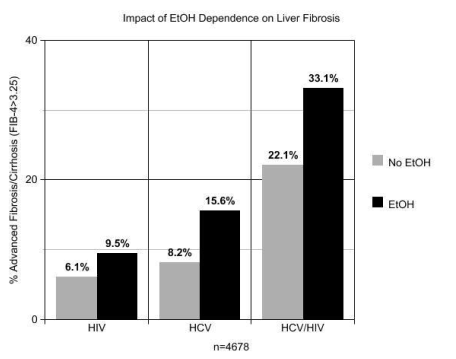 |
 |
 |
| |
Alcohol Abuse & Dependence Has Big Impact on Cirrhosis in HIV/HCV Coinfection
|
| |
| |
Impact of Alcohol Abuse and Dependence On Liver Fibrosis in a Prospective Cohort of 6090 HIV+/Hiv- U.S. Veterans
Joseph K Lim1, Shawn L Fultz2, Joseph L Goulet1, Joseph Conigliaro3, Kendall J Bryant4, Adam J Gordon5, Cynthia L Gibert6, David A Fiellin1, Amy C Justice1
1. Yale U. and West Haven VAMC, New Haven, CT, USA, 2. Veterans Administration, OPHEH, Washington, DC, USA, 3. U. of Kentucky and Lexington VAMC, Lexington, KY, USA, 4. NIH/NIAAA, Bethesda, MD, USA, 5. U. of Pittsburgh and Pittsburgh VAMC, Pittsburgh, PA, USA, 6. George Washington U., Washington, DC, USA
BACKGROUND: Liver injury is common among HIV-infected individuals, and often caused by HBV/HCV or HAART. Although alcoholic liver injury is well-described,the impact of varying levels of alcohol consumption is poorly defined.
METHODS:The Veterans Aging Cohort Study(VACS) is a longitudinal study of 6090 age/sex matched HIV+/HIV- veterans at 8 U.S. sites, with detailed baseline and longitudinal data on HIV/HBV/HCV status, HAART use, and alcohol consumption(AUDIT,CIDI-SAM,ICD-9). Non-hazardous, hazardous and binge drinking were defined by NIAAA criteria. Liver injury was assessed by inflammatory and fibrosis markers(AST,ALT,FIB-4). Logistic regression was used to determine the proportion of liver injury due to alcohol after controlling for age,sex,body mass,HIV,and HBV/HCV.
RESULTS:
Complete data were available for 4678 veterans,of whom 425(9.1%) had advanced fibrosis/cirrhosis(FIB-4>3.25),including 12.5% of HIV+ and 4.4% of HIV- subjects. A trend towards increased liver injury was seen with hazardous or binge-drinking, but a statistically significant increase in advanced fibrosis/cirrhosis was seen only in those with a ICD-9 diagnosis of alcohol abuse and dependence(AAD),including those with HIV alone(9.5%),HCV alone(15.6%),and HCV/HIV(33.1%).
In multivariate analysis, after controlling for HCV and HIV, alcohol was the strongest correlate of advanced fibrosis/cirrhosis(OR=2.19, p<0.05). Age>50 years,black race,and HBV were also significant correlates. Of subjects with advanced fibrosis/cirrhosis, 38.7% had a diagnosis of AAD.
CONCLUSIONS: Alcohol abuse and dependence is common among individuals with advanced fibrosis/cirrhosis. In a large prospective cohort of U.S. veterans, AAD significantly increased the risk of advanced fibrosis/cirrhosis among those with HIV,HCV,and HCV/HIV coinfection; this effect was not seen in lesser degrees of alcohol consumption.

|
| |
|
 |
 |
|
|